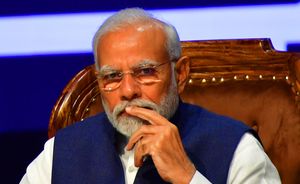But there is no alternative!” is the favourite quip of many liberal educated Indians when they want to end an uncomfortable discussion about the unsavoury direction Indian politics and society have taken under Narendra Modi’s ‘New India’. Each time the now rampant culture of bigotry, hate speech, Islamophobia, mob lynchings, blatant disregard for constitutional procedures, unconstitutional actions of agencies of the state, the misuse of ED-CBI and other state agencies, crony capitalist corruption, demonetisation, price rise, unemployment or China’s encroachment of Indian territory is brought up, the educated rational, liberal, ‘I-don’t-hate-Muslims’ elite Indian brings up the ‘TINA factor’.
TINA, which stands for ‘there-is-no-alternative’, is a myth popularised in public discourse and common sense understanding of Indian politics by the media and social media ecosystems much like the ‘Rahul Gandhi is a Pappu’ narrative. Both these popular ideas have ensconced in public discourse the notion that if not Modi then who?
The argument is that while there may be several valid critiques of Modi’s governance of India in the last nine years, people keep voting for Modi because there is no other alternative to effectively lead and govern the country, and surely they can’t be expected to vote for Pappu Rahul Gandhi! And so we must keep living with growing human rights abuses, corruption and authoritarianism because if-not-Modi-then-who? Pro-BJP journalists and opinion makers have also pushed this narrative enthusiastically, the subtext being that the BJP under Modi is invincible.
The decisive victory that the Congress has won in the Karnataka assembly elections has, however, challenged this fallacy. The campaign the BJP ran, headlined by Modi, was high on communal rhetoric with Modi equating Bajrang Dal with Bajrang Bali (Lord Hanuman) and violating the code of conduct by asking for votes in the name of Bajrang Bali.
In the past these pre-election techniques worked (most successfully in Gujarat and Uttar Pradesh), but the Karnataka loss has upturned the BJP’s communal apple cart. The Congress campaign—targeting the state BJP for corruption, foregrounding the message of unity with Rahul Gandhi’s Bharat Jodo Yatra and focusing on local issues and leaders—seems to have resonated with voters. The Congress took a clear line on secularism. It spoke out clearly for the poor without worrying about how elites would perceive its platform. The results vindicated it. And, with this win, the narrative of BJP’s invincibility and the TINA factor myth have been punctured as well.
But it is worth asking ourselves: Is the TINA factor an accurate assessment of the Indian voters predicament these past few years? A look at regional elections and ground level activism tells us that India has been throwing up a variety of local political alternatives. In 2018, months after the huge BJP sweep in assembly elections of 2017, the Congress under its supposed Pappu won Rajasthan, Madhya Pradesh (now BJP ruled) and Chhattisgarh. Recently it has added Himachal Pradesh (and now Karnataka) to its kitty. Other parties have come to power in Delhi, Punjab, West Bengal, Telangana, Andhra Pradesh, Odisha, Kerala, Jharkhand and Mizoram. The point is that states in India have been finding alternative leadership to Modi’s BJP since the last five years at least.
But alternatives don’t only come from elections. They take birth in mass movements. In just the last three years India witnessed two major protests. In December 2019 the nationwide student- and women-led CAA-NRC protests began, which lasted till March 2020, and, in November, 2020, farmers from Punjab, Haryana and Rajasthan began the farmers’ protests against the farm laws. The farmers won their fight with Modi repealing the laws. While the CAA-NRC protests ended with the ugly Delhi riots, it is noteworthy that the government has so far put the NRC campaign on the back-burner. Such mass protests present alternatives—an alternative vision for India, an alternative political language, and, hopefully, an alternative future.
If this is the present-day ground reality in India, maybe it is time to ask ourselves who is peddling the TINA factor narrative and who does this fallacy serve? Because voters are decisively voting for the alternative, when they see it.
The writer is an award-winning Bollywood actor and sometime writer and social commentator.


